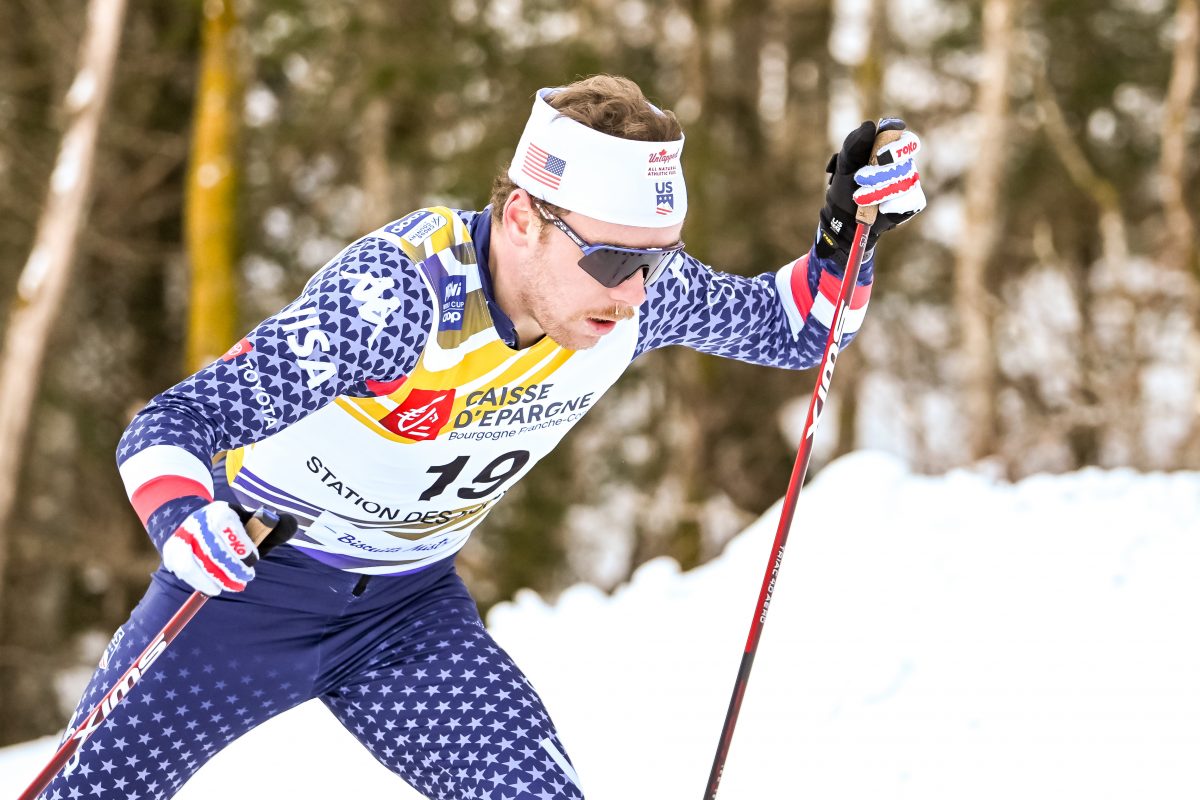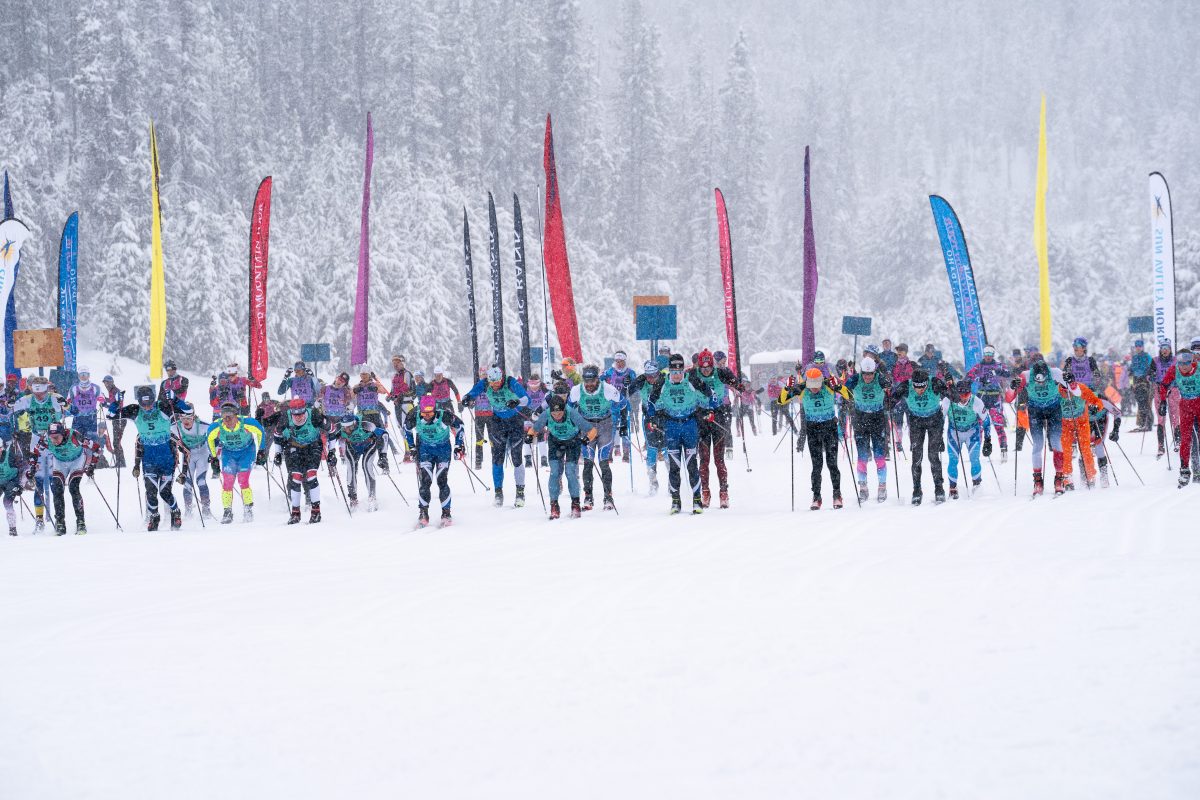 This World Cup coverage is made possible through the generous support of Marty and Kathy Hall and A Hall Mark of Excellence Award. To learn more about A Hall Mark of Excellence Award, or to learn how you can support FasterSkier’s coverage, please contact info@fasterskier.com.
This World Cup coverage is made possible through the generous support of Marty and Kathy Hall and A Hall Mark of Excellence Award. To learn more about A Hall Mark of Excellence Award, or to learn how you can support FasterSkier’s coverage, please contact info@fasterskier.com.
There had been glimpses of Swedish firepower all day. Into the first exchange, Calle Halfvarsson (SWE) had shot through the field. When Federico Pellegrino (ITA) broke away on leg three, Edvin Anger (SWE) had done enough to stick with the lead pack. It wasn’t until the last hill on the last leg, though, that the roar surged up from the Swedish crowd gathered in Falun. The newly-crowned world sprint champion—Sweden’s sprint champion—Jonna Sundling, launched away from the field and finished the mixed 4 x 5 k team relay with a home win.

It was the second consecutive year that Falun played host to a mixed relay to close out its annual World Cup weekend, but the first time it gained “official” designation after having been a test event last season. In that test last year, the United States’ closed the season with a win. In the first “official” running in Beitostolen last December, Norway dominated on home soil. The mixed 5 k relay is new game to play skiing-wise, with teams and organizers alike still figuring out the rules and tactics. There’s obvious appeal in the format, and the appeal of watching skiing’s best athletes and tacticians figure something new out in real-time. Take one of skiing’s longest running formats—the distance team relay—and inject it with the currents the sport has been riding the past few years. Old and new: what’s not to like?
For the athletes racing, unpredictability was a main selling point. Hailey Swirbul said to FasterSkier that, “I appreciate the unpredictable aspects of relay day- you never know what your race will look like because it depends completely on what the racers before you have done out on course. I always find it easier to push to a painful place when I have teammates counting on me, much more so than I’m able to in an individual race. I love the energy of the team events.”
The latest tinkering with the new mixed relay format meant that, in Falun, women would finish the race in the anchor leg while the men would lead out the race in the first classic leg. That switch had observers eyeing which of the best from the women’s field were slotted in the fourth spot; almost all eyes were turned to Sundling who would finish out Sweden I’s lineup of Halfvarsson, Moa Ilar, Anger. The anchor leg geared towards the sprinters, with Anne Kjersti Kalvaa on for Norway I, Victoria Carl on for Germany I, and Julia Kern on for USA I. The rest, though, was a mix of skills and specialties that would provide a mixed up race. At times, the best sprinters and the best distance skiers were on course at the same time, skiing the same course, in very different ways. In Leg 3, for example, 50 k World Champion and Holmenkollen winner Simen Hegstad Krueger (Norway I) and Federico Pellegrino (Italy I) were trading blows head-to-head.

The excitement surrounding that roster of big names, however, put into relief how many other big names were absent. The Team Relay is a non-scoring World Cup event in the new World Cup point system, leading most skiers contending for World Cup Crystal Globes to sit out the event. The top five women in the Cup standings were all absent today, including Jessie Diggins and Rosie Brennan. The United States fielded two teams with Ben Ogden leading the USA I lineup that included Novie McCabe, Scott Patterson, and Julia Kern. USA II included Luke Jager, Hailey Swirbul, Kevin Bolger, and Sammy Smith.
Mixed 4 x 5 k Team Relay

Ben Ogden began the week of World Cup racing with a full-gas effort in Drammen’s city sprint heats. He would end his week the same way. Ogden pushed the pace from the beginning of the scramble leg; through the rest of the lap it just kept gaining momentum. Canada’s Antoine Cyr strided up to Ogden, then Norway I’s Martin Loewstroem Nyenget pushed it at three kilometers. By four kilometers, the pace was a full sprint. A strung-out field ultimately snapped as the leaders ran up the final climb, with Halfvarsson putting in an extra burst to bring a lead pack—Sweden I, Norway I, Norway II, Italy I, Canada I—into the first exchange. Ogden had initiated the moves, and he continued hanging on by a thread. He led USA I into the exchange (10 seconds behind the leaders) at the front of a chase group that contained USA II’s Luke Jager who managed to enter the exchange in eighth.
In post-race comments to FasterSkier, Ogden said that, “todays race was fun, [but] 5k is definitely a tricky distance. You can’t just charge from the beginning, but you are able to hold a very high pace for the entire distance. In todays scramble leg I started out pretty hard and couldn’t help myself from cranking up the big climb. We had fabulous kick and it’s just such s perfect hill for striding I was loving It. After that in the last two k or so the Norwegian cranked up the pace in the double pole and I fell off just a little bit before the sprint course and stadium where It was just an all out sprint to the tag zone.”
The second leg saw a steady pace that contrasted the bashings and bursts of the first. The main action came from Germany I’s Katharina Hennig, who took a hand-off from Albert Kuchler in 11th place, but by the end of her lap had pulled her team into first place. That put Germany I into a lead pack alongside Norway I, Norway II, and Sweden I, with Italy I in contact enough through the hand-off from Caterina Ganz to Federico Pellegrino that they could rejoin the pack in the early part of leg 3. Hailey Swirbul skied from the chase group to keep USA II in 6th place, alongside Canada I’s Katherine Stewart-Jones in 7th. USA I was in 11th with Novie McCabe handing off to Scott Patterson.
Hailey Swirbul pointed to an ability to embrace the new challenges of the mixed relay as contributing to her strong performance today, saying post-race to FasterSkier that, “It was quite fun to be on leg two of a relay for the first time I can remember! I have really enjoyed being the scramble leg for many of the relays I have been part of, but the mixed relay provides a different opportunity with the men racing first. I thought it was fun to be on the hunt, rather than be hunted or try to defend my space.”
Simen Hegstad Krueger (Norway I), Harald Oestberg Amundsen (Norway II), Anger (Sweden I), and Pellegrino (Italy I) got caught in tactical stasis on leg 3, as the sprinters—Pellegrino and Anger—looked to mark the Norwegian distance duo. That allowed Germany I’s Anian Sossau to hang onto the lead group. While Krueger did lift the pace three kilometers into the lap—dropping Sossau from the lead pack—the lapse allowed the Germans to stay within striking distance. Pellegrino put in a move to the outside on the final climb that gave Italy as much advantage as he could produce. That advantage turned out to be less than a second, as Amundsen handed off to Ragnhild Gloeersen Haga for Norway II and Krueger handed off to Anne Kjersti Kalvaa for Norway I. Sweden I was in fourth, and Germany exchanged from Sossau to Victoria Carl in fifth, 11.6 seconds back. Kevin Bolger kept USA II in the top ten in eighth place, while Scott Patterson handed off to Julia Kern for USA I in 13th place.

As Sundling wound through the last lap for Sweden I, the race grew tense. The Norwegian pair of Kalvaa and Haga would have to make a move; it was just a matter of when. Behind them, Germany’s Victoria Carl was working her way back to the lead back with simple grit: 1.5 kilometers into the lap, she had cut the gap in half. By the 2.5 kilometer mark, she was back in contact. Then, the pack went again: Kalvaa accelerated at the four kilometer mark, but Sundling led over the top of the hill opening the winning gap over with Kalvaa. At the finish line, Sundling eased into the arms of her teammates. Kalvaa did the same in second. Victoria Carl put the finishing touches on her superb comeback, and threw a boot over the line to put the Germany I team on the podium in third place. Behind her, Julia Kern was showing the same kind of grit for USA I. Kern moved from thirteenth to finish in eighth place, with a split that only Carl and Sundling surpassed. USA II finished eleventh, behind the relay debut of Sammy Smith.
Mixed Team Relay Kicks off World Cup’s “Experimental” Phase
The kind of tinkering and the toying on display throughout the Mixed Team Relay continues next week during World Cup events in Tallinn, Estonia when that city will host a city-center sprint on Tuesday. This first-ever World Cup stop in the Estonian capital will also act as a test event for the initiation of World Cup wax protocols. For the first time, a World Cup event will be conducted with all skiers utilizing the same glide wax: no miracles and mysteries from the somewhere deep in the wax trucks; everyone will race on exactly the same wax.
Next week will also mark the resumption of the chase for the Overall Crystal Globe, as the World Cup quickly winds towards its final weekend in Lahti, Finland.
Mixed 4 x 5 k Team Relay RESULTS

Ben Theyerl
Ben Theyerl was born into a family now three-generations into nordic ski racing in the US. He grew up skiing for Chippewa Valley Nordic in his native Eau Claire, Wisconsin, before spending four years racing for Colby College in Maine. He currently mixes writing and skiing while based out of Crested Butte, CO, where he coaches the best group of high schoolers one could hope to find.



